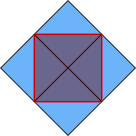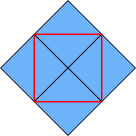Diagonal Side
Can you work out the area of a square drawn on a diagonal?
Problem
The diagonal of a unit square is used as one of the sides of a new square.
What is the area of this new square?
(A unit square is a square whose sides all have length 1 unit, and so its area is 1 square unit)
This problem is taken from the World Mathematics Championships
What is the area of this new square?
(A unit square is a square whose sides all have length 1 unit, and so its area is 1 square unit)
This problem is taken from the World Mathematics Championships
Student Solutions
Measuring using unit squares

The side length of the square is equal to the diagonal of the unit square, as shown in the diagram on the right, where the red length is the side of the new square and the blue square is a unit square.


Sticking four of these together, as shown on the left, draws the whole square. The unit squares fit perfectly together as the red lines split them in half, and so each angle is 90$^\text o $
or 45$^\text o$.
The area of the square is shaded in the diagram on the right. It contains four half-unit-squares - so its area is four half-units, or two whole units.
Using Pythagoras' Theorem to find the side length

If this square is a unit square, then its diagonal, shown in red, will be the side length of the square.
Applying Pythagoras' Theorem to the triangle will give us information about this length, here called $c$: $1^2+1^2=c^2\Rightarrow2=c^2$
But $c^2$ is the area of the square with side length $c$. So if $c^2=2$, then the area is $2$.
Image

Image

Image

The area of the square is shaded in the diagram on the right. It contains four half-unit-squares - so its area is four half-units, or two whole units.
Using Pythagoras' Theorem to find the side length
Image

Applying Pythagoras' Theorem to the triangle will give us information about this length, here called $c$: $1^2+1^2=c^2\Rightarrow2=c^2$
But $c^2$ is the area of the square with side length $c$. So if $c^2=2$, then the area is $2$.
